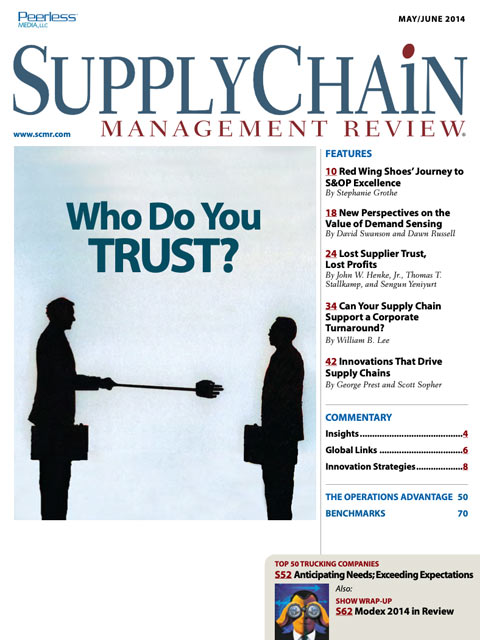Sorry, but your login has failed. Please recheck your login information and resubmit. If your subscription has expired, renew here.
May-June 2014
Getting the most from Sales and Operations Planning is a combination of people, processes, and technology. The Red Wing Shoe Company details the steps it took to improve S&OP processes, slash its S&OP planning efforts by 50 percent, and align manufacturing with sales—all while growing its business. Browse this issue archive.Need Help? Contact customer service 847-559-7581 More options
Last holiday season, many retailers and their suppliers were shocked by 11th hour shifts in demand, with much of the surprise coming from a surge in e-commerce orders.
As recently as a decade ago, it wasn’t unusual for businesses to be hit with much larger or smaller orders than they had been expecting—and for those orders to arrive earlier or later than anticipated. But since then, the discipline of forecasting has improved markedly, with mathematically tractable models providing more useful predictions of demand. So why, in the first decade of the 21st century, are businesses still surprised—and hobbled—by sharp shifts in demand?
The truth is that lack of accuracy still plagues forecasting efforts. A precision forecast of demand is essential for the successful utilization of advanced planning tools. Until recently, demand forecasting primarily involved analyzing historical information using quantitative and qualitative methods. But in categories such as e-commerce, the historical data is too thin to be truly useful.
 |
This complete article is available to subscribers
only. Click on Log In Now at the top of this article for full access. Or, Start your PLUS+ subscription for instant access. |
Not ready to subscribe, but need this article?
Buy the complete article now. Only $20.00. Instant PDF Download.
Access the complete issue of Supply Chain Management Review magazine featuring
this article including every word, chart and table exactly as it appeared in the magazine.
SC
MR
Sorry, but your login has failed. Please recheck your login information and resubmit. If your subscription has expired, renew here.
May-June 2014
Getting the most from Sales and Operations Planning is a combination of people, processes, and technology. The Red Wing Shoe Company details the steps it took to improve S&OP processes, slash its S&OP planning… Browse this issue archive. Access your online digital edition. Download a PDF file of the May-June 2014 issue.
 |
Download Article PDF |
Last holiday season, many retailers and their suppliers were shocked by 11th hour shifts in demand, with much of the surprise coming from a surge in e-commerce orders.
As recently as a decade ago, it wasn’t unusual for businesses to be hit with much larger or smaller orders than they had been expecting—and for those orders to arrive earlier or later than anticipated. But since then, the discipline of forecasting has improved markedly, with mathematically tractable models providing more useful predictions of demand. So why, in the first decade of the 21st century, are businesses still surprised—and hobbled—by sharp shifts in demand?
The truth is that lack of accuracy still plagues forecasting efforts. A precision forecast of demand is essential for the successful utilization of advanced planning tools. Until recently, demand forecasting primarily involved analyzing historical information using quantitative and qualitative methods. But in categories such as e-commerce, the historical data is too thin to be truly useful.
 |
SUBSCRIBERS: Click here to download PDF of the full article. |
SC
MR

Latest Supply Chain News
- AI, virtual reality is bringing experiential learning into the modern age
- Humanoid robots’ place in an intralogistics smart robot strategy
- Tips for CIOs to overcome technology talent acquisition troubles
- There is still work to do to achieve supply chain stability
- Blooming success: The vital role of S&OE in nurturing global supply chains
- More News
Latest Resources

 Explore
Explore
Topics
Latest Supply Chain News
- AI, virtual reality is bringing experiential learning into the modern age
- Humanoid robots’ place in an intralogistics smart robot strategy
- Tips for CIOs to overcome technology talent acquisition troubles
- There is still work to do to achieve supply chain stability
- Blooming success: The vital role of S&OE in nurturing global supply chains
- Supply chain salaries, job satisfaction on the rise
- More latest news
Latest Resources

Subscribe

Supply Chain Management Review delivers the best industry content.

Editors’ Picks





